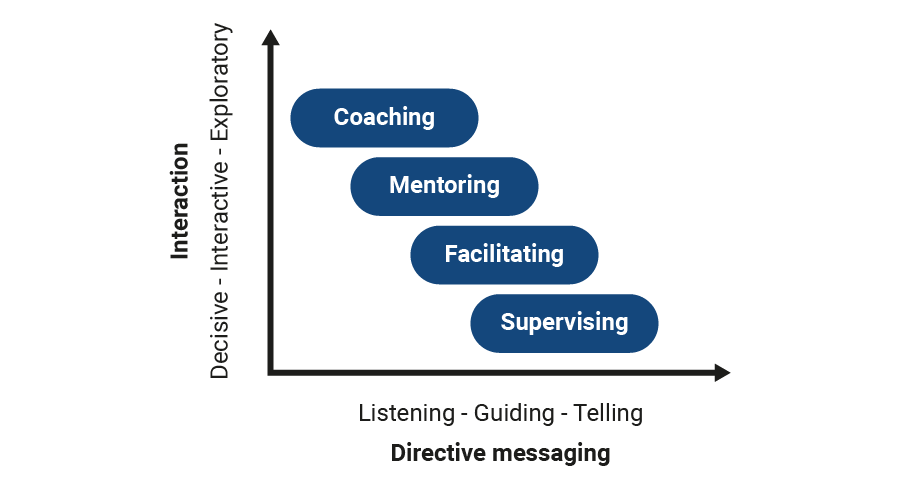Coaching for Success
Coaching compared to supervising and mentoring
Coaching is different to supervising, facilitating and mentoring, and is a valuable and necessary addition to the conversation toolkit that WIL partners can use to support and develop students.
So what's the difference between coaching, mentoring and supervising? Throughout this module you'll see the direct reference to those three terms and they're treated as very distinct approaches to the work integrated learning relationship between partners and students. Typically we try and break this down based on the level of engagement that you're having with the student and also, I guess the level of answer your providing to that student as well. In the case of supervising its quite a direct relationship so we would think that a question from a student would be answered with a direct response, essentially providing them with the answer to the problem which is very efficient but not necessarily allowing the student to think critically for themselves. In a mentoring relationship we might see that same question answered in a slightly different way where the mentor might recall some of their own experiences can say well this type of approach has worked for me but how might this work for you in your circumstance. From a coaching perspective that same question would simply be answered with another question. A question that asks the student to reflect on their own thought processes to identify their priorities, what they think is important in this particular situation and identifying perhaps a process for how they might solve that particular problem. This approach allows students to develop a deeper understanding of the knowledge that they actually have to bring to the table to solve that particular problem and also allows them to think critically about they can solve problems that they might be a bit uncertain on. By a coach supporting that thought process with the right questions it helps that student to develop experience in navigating those problems on their own so that eventually they can do that on their own and develop confidence that they can navigate that period of uncertainty and ambiguity with success.
Mentoring
Mentoring allows WIL partners to invest time, knowledge and effort [1] to provide advice and support[2], and role modelling[3], to help less experienced students quickly identify efficient pathways to achieve goals.
Supervision
Supervision typically supports and reinforces students’ use of training and instruction [4] in their WIL activities to ensure oversight and accountability[5].
Facilitation
Facilitation is a little more arm’s-length in steering students in the right direction, and involves the WIL partner to act as a neutral party that has no decision-making authority[6], to help students to 'apply evidence into practice'[7] so that 'all aspects of a project are investigated, defined, described, developed and delivered.'[8]
The coaching difference
Coaching, however, requires WIL partners to develop students through collaborative, reflective practice – where the WIL partner asks questions that allow the student to reflect on what is important in order to identify areas for improvement and critically think about the ways of improving outcomes. These different modes of WIL partner – student interaction, based on their level of directive messaging and level of interaction, are plotted in the image below, allowing us to see the pragmatic differences between the approaches.

Student check point
The figure above can be used to think critically about how you can frame questions to your WIL partner when you need a problem solved. Do you have the time and energy available to pursue a richer mode of interaction (i.e. are you seeking interactive or exploratory conversation)? Do you have an opinion about what you think the answer might be (would you like the WIL partner to guide or listen)?
The nuances of each mode of interaction send important signals to students with respect to their expectations of how to respond to WIL partner discussions, and how to think about the tasks they are facing. Let’s explore this through the example on the next page.
Wil partner check point
The four modes of interaction illustrated in the above figure can be thought of as different conversation tools to help develop students’ experience, sense-making, and productivity in a WIL environment. Pragmatically, not every conversation can be a coaching conversation, so it is important to understand when different approaches might best fit the situation and the student to ensure a balance is struck between efficiency and learning in the workplace.
- (Weinberg, & Lankau, 2010, p1)
- (Baugh, & Fagenson-Eland Ellen, 2006, p1)
- (St-Jean, Radu-Lefebvre, & Mathieu, 2018, p1)
- (Govaerts, Kyndt, Vreye, & Dochy, 2017, p1)
- (Tsui, O’Donoghue, Boddy, & Pak, 2017)
- (Wardale, 2013)
- (Tiberg, Hansson, Homberg, & Halltroem, 2017, p. 579)
- (Freytag, & Storvang, 2016)
